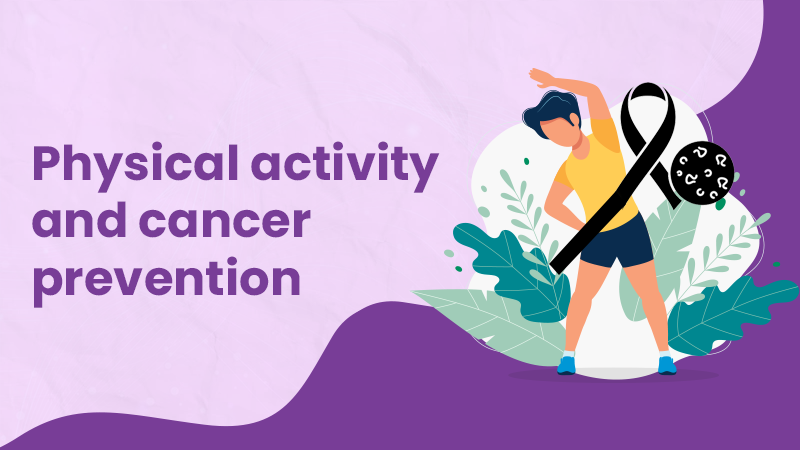Physical Activity And Cancer Prevention: The Whats, Whys, And Hows
- 38 months ago
The world is a continuously changing place, smothering us with all kinds of pleasures and comforts that keep pushing us further deep into our couches. This might seem fulfilling in the initial stages, but something as basic as being lazy can have a severe impact on your physical and mental being. Bringing minute changes in lifestyle regularly can help you a long way in ensuring longevity and keeping diseases and complications at bay. One of these changes is incorporating physical activity into our daily lives. Observational studies have shown that the benefits of physical activity extend to cancer prevention, cure, and recovery. Here’s what you need to know about how to fight cancer with physical activity, its relationship with cancer prevention and cancer treatment, the influence it has, and where to start.
Myth or Fact? Does physical activity help with cancer?
To begin with, first, we need to understand what counts as physical exercise. The National Cancer Institute Recognises physical activity to be any kind of movement that “uses skeletal muscles and requires more energy than resting”. Ranging from slight movements like walking to weight training are recommended for people undergoing cancer treatment, the survivors as well as for every other person looking to prevent cancer naturally.
New guidelines have been recently published that advocate in favor of the incorporation of physical activity not only as a means of cancer treatment but also in favor of incorporation of exercises during cancer treatment to see better outcomes of those treatments. These guidelines are devised by experts from various institutions such as the American College of Sports Medicine and the American Cancer Society. Three academic papers published concerning this debate talk of the preventative qualities that physical activity that help fight cancer found in the bladder, breast, colon oesophagus, kidney, stomach etc.
The importance of physical exercise has found relevance in the lives of cancer survivors as well. This is validated by a report released in 2018 by the American College of Sports Medicine Internation Multidisciplinary Roundtable on Physical Activity and Cancer Prevention and Control. It helps in coping with anxiety that often follows cancer treatment. Rigorous medical treatment often induces fatigue and makes one lethargic. Exercising in small bits every other day helps your brain and body stay up and about.
How does exercise help?
Exercising regularly helps in reducing inflammation, regulating blood sugar, and improving metabolism. Apart from these general influences, exercising also has a more specific and localized impact. Risk is curtailed by regulating issues such as obesity. It also contributes to in lowering of sex hormones which helps in keeping breast and colon cancer at bay. Bowel movement is stimulated when you exercise which further results in a much faster passage of waste thus ensuring reduced contact with cancer triggering agents.
By regulating the metabolism of bile acids, it helps in reducing the effect and exposure of suspected carcinogens to the gastrointestinal tract.
Another contribution is the reduction of insulin. When you are active your body produces less insulin which helps in avoiding or reducing tumor growth.

The benefits of exercising extend to mental well being too. While an active body ensures a healthy body, it also ensures a healthy mind. Cancer can be a very difficult illness to come to terms with. It brings a lot of anxiety and trauma with it. Exercising helps in channelizing these emotions and reduces the risk of depression and clinical anxiety. It helps in making a person more aware of their condition, their safety and makes them more focused and solution-oriented.
Time to devote exercises to incorporate
It is generally suggested by institutes such as the National Cancer Institute that 30 minutes of aerobic activity at least three times a week coupled with strength training at least 2-3 times a week is a decent amount of exercise for cancer patients. It is, however, general advice. A lot of variables will be at play here, so one should consult their physician for more tailored and individual-specific routines. The aim is to cut extra fat, keep your heart rate healthy and mind and body running.
Exercises during cancer treatment that can help
Stretching:
Exercises like spine twisting, arm and leg stretch etc, increase the blood flow resulting in a better supply of oxygen throughout. It helps in recovering from the muscle stiffness that often results from radiation therapy.
Brisk Walk/ Running:
These exercises usually come under cardio and help in improving your lung and heart health. This helps to relieve muscle stiffness. Early morning walks can also be great for your mental well being.
Seated Meditation:
Benefits of meditation are innumerable and can’t be emphasised enough. Much of our recovery depends on how we are feeling. Meditation helps in reducing anxiety, stress, fatigue etc.
As your situation improves and after understanding the extent to which you can exert your muscles, you can eventually incorporate exercises like swimming, cycling, running etc.
Things to keep in mind
- Do not overdo. Injuries are the most common downside to exercising.
- Do not carry out any routine without consulting your doctor.

Ensure that what you do is suitable for your body and will not backfire in future








